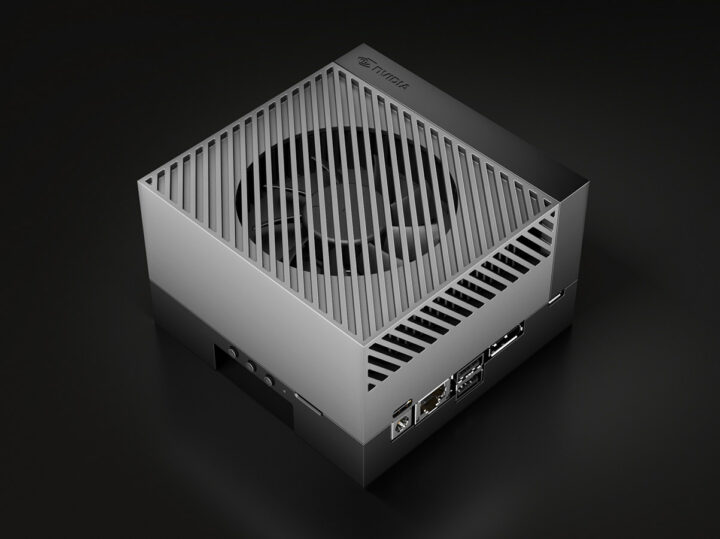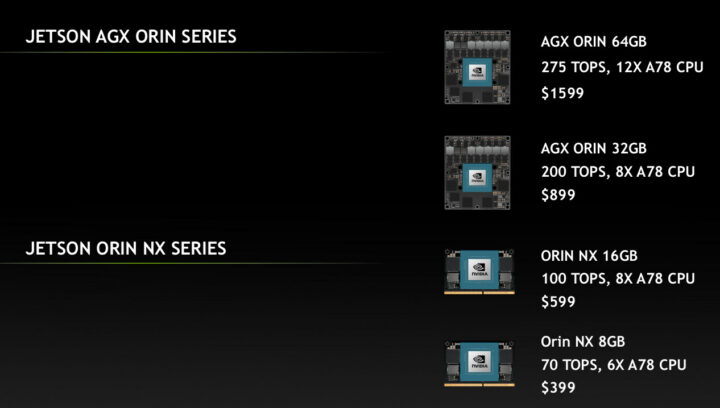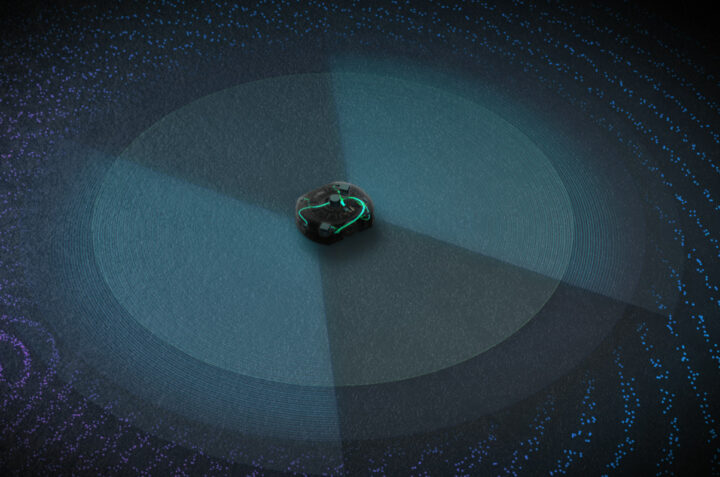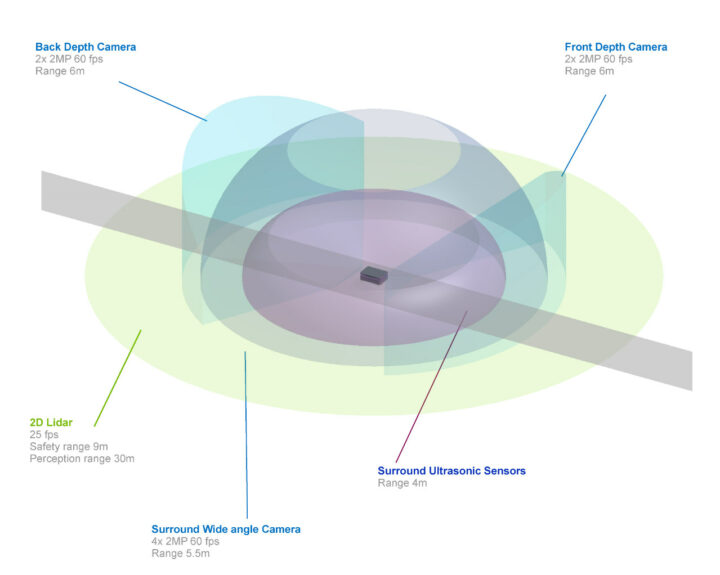NVIDIA Jetson AGX Orin module was first introduced in November 2021, but the company has now officially launched the Jetson AGX Orin Developer Kit, andunveiled the lower cost Orin NX modules still with 70 TOPS or more, and the Isaac Nova Orin AMR (autonomous mobile robot) reference platform.
NVIDIA Jetson AGX Orin Developer Kit
Jetson Orin AGX developer kit specifications:
- Jetson AGX Orin module with
- CPU – 12-core Arm Cortex-A78AE v8.2 64-bit processor with 3MB L2 + 6MB L3 cache
- GPU / AI accelerators
- NVIDIA Ampere architecture with 2048 NVIDIA CUDA cores and 64 Tensor Cores @ 1.3 GHz
- DL Accelerator – 2x NVDLA v2.0
- Vision Accelerator – PVA v2.0 (Programmable Vision Accelerator)
- AI Performance – Up to 275 TOPS (INT8) @ 60W
- Video Encode – 2x 4K60 | 4x 4K30 | 8x 1080p60 | 16x 1080p30 (H.265)
- Video Decode – 1x 8K30 | 3x 4K60 | 7x 4K30 | 11x 1080p60| 22x 1080p30 (H.265)
- System Memory – 32GB 256-bit LPDDR5 @ 204.8 GB/s
- Storage – 64GB eMMC 5.1 flash
- 699-pin Molex Mirror Mezz connector with
- Storage – Single lane UFS
- Display – 1x 8K60 multi-mode DP 1.4a (+MST), eDP 1.4a, HDMI 2.1
- Camera
- Up to 6x CSI Camera (16 via virtual channels)
- 16 lanes MIPI CSI-2
- D-PHY 2.1 (up to 40Gbps) | C-PHY 2.0 (up to 164Gbps)
- Networking – 1x GbE, 4x 10GbE
- PCIe – Up to 2x PCIe x8, 1x PCIe x4, 2x PCIe x1 (PCIe Gen4, Root Port & Endpoint)
- USB – 3x USB 3.2, 4x USB 2.0
- Low-speed IOs – 4x UART, 3x SPI, 4x I2S, 8x I2C, 2x CAN, DMIC & DSPK, GPIOs
- Power Modes – 15W, 30W, 50W, or 60W
- Dimensions – 100 x 87mm
- Carrier board
- Storage – MicroSD slot for UHS-1 cards up to SDR104 mode
- Video Output – DisplayPort 1.4a (+MST)
- Camera I/F – 16 lane MIPI CSI-2 connector
- Networking – Up to 10GbE RJ45 port
- USB
- 2x USB 3.2 Gen2 Type-A ports
- 2x USB 3.2 Gen1 Type-A ports
- 2x USB 3.2 Gen 2 Type-C ports
- 1x Micro USB 2.0 port
- Expansion
- x16 PCIe slot supporting x8 PCIe Gen4
- M.2 Key M x4 PCIe Gen 4
- M.2 Key E x1 PCIe Gen 4, USB 2.0, UART, I2S
- 40-pin header (I2C, GPIO, SPI, CAN, I2S, UART, DMIC)
- 12-pin automation header
- 10-pin audio panel header
- Debugging – 10-pin JTAG header
- Misc – 4-pin fan header; 2-pin RTC battery backup connector; power, force recovery, and Reset buttons
- Dimensions – 110 x 110 x 71.65mm (Height includes feet, carrier board, module, and thermal solution)
The kit ships with the Jetson AGX Orin module with heatsink and reference carrier board, an 802.11ac/a/b/g/n WiFi 5 module, a power adapter and USB Type-C cord, a USB Type-C to USB Type-A cord, and a Quick Start and Support Guide.
On the software side, Jetson AGX Orin can make use of the NVIDIA CUDA-X accelerated computing stack, NVIDIA JetPack SDK, pre-trained models from the NVIDIA NGC catalog, and frameworks and tools such as NVIDIA Isaac on Omniverse, NVIDIA Metropolis, and NVIDIA TAO Toolkit.
Basic support for the Jetson Orin AGX developer kit also happens to have just been added to Linux 5.17. The devkit can be purchased for $1,999 and more information can be found on the product page.
Jetson Orin NX modules
If spending close to $2,000 on a development kit, and then $1,599 on modules is not cost-effective for your project, the company provides four options, including two lower-cost SO-DIMM Orin NX modules:
- AGX Orin 64GB with 275 TOPS, 12x Cortex-A78 CPU for $1,599 (as found in the devkit)
- AGX Orin 32GB with 200 TOPS, 8x Cortex-A78 CPU for $899
- Orin NX 16GB with 100 TOPS, 8x Cortex-A78 CPU for $599
- Orin NX 8GB with 70 TOPS, 6x Cortex-A78 CPU for $399
Note the prices are for 1K unit orders, and mass production is scheduled to start in Q4 2022.
Isaac Nova Orin AMR platform
NVIDIA also introduced the Isaac Nova Orin reference platform powered by 2 Jetson AGX Orin units to speed up the development of 3D-sensing robots with up to 550 TOPS of AI compute for perception, navigation, and human-machine interaction.
The robot can handle up to six cameras, three lidars, and eight ultrasonic sensors and process data in real-time. NVIDIA is also working on new software and simulation capabilities to accelerate AMR deployments including hardware-accelerated modules, or Isaac ROS GEMs.
The video below shows AMR visual navigation using Isaac Sim and Isaac ROS, and demonstrates how virtual worlds like NVIDIA Omniverse can be used in practical applications, in this case, simulate various warehouse environments to test the robot’s capabilities.
More details about NVIDIA AMR solutions can be found on the product page.

Jean-Luc started CNX Software in 2010 as a part-time endeavor, before quitting his job as a software engineering manager, and starting to write daily news, and reviews full time later in 2011.
Support CNX Software! Donate via cryptocurrencies, become a Patron on Patreon, or purchase goods on Amazon or Aliexpress









yikes, what a hyper-inflation on the price tags for the AGX Orin compared to the AGX Xavier. After the disappointment about the RK3588 price level and now this, more and more people are gonna lose hope about the viability of ARM in that segment and turn back to x86_64… unless of course one has no other choice but to cough up for lack of required specific interfaces (e.g. MIPI-CSI or -DSI) in the x86 world. If any Intel or AMD manager is reading this: They could do a ton of money right now and grab a big chunk of the… Read more »
This is what the end of Moore’s law looks like. It has nothing to do with ARM vs. X86. Each new node comes with a hefty jump in wafer prices and a diminishing return in performance and density. The best path to gains now is to devote more die space to specialized tasks, increase the complexity of packaging (chiplets, stacking, etc.), and put more strain on the power supply and cooling systems. All of those strategies have diminishing returns as well. I suspect FPGA fabric will start to play a roll soon. It’ll show up in active interposer tiles that… Read more »
Yes, Nvidia, of course I would purchase 1000 units at a way too high price, who wouldn’t ?
That aside, the PCIe expansion and other specs look quite interesting.
-I just wish they wouldn’t use the “Apple pricing model”.
yeah looks like the apple price model indeed, but i guess this would beat the M1 in a jiffy and it you would be free, it would not be the apple way or the highway.
> Orin NX 8GB with 70 TOPS, 6x Cortex-A78 CPU for $399
Goodbye RK3588, even if single units will be a bit more expensive that’s fine.
Do you think the Orin NX SO-DIMM module uses the same pin-out as Jetson Nano / Xavier NX? Since if not good luck finding/designing an affordable carrier board…
A little leap of faith has never hurt anyone.
Out of curiosity: which use case are you after? A little box to be used as a ‘desktop computer’ or something else?
Test bed for a chess engine using UCT search + a small NN. Just a hobby project.
It’s still somewhat ok compared to using an desktop + RTX card… Provided I can reuse the old carrier board.
I listened to an embargoed video for the press, and I understood they kept backward compatibility.
Hmm… never looked at it in detail (since everything Nvidia Jetson is completely uninteresting if you can not make use of all the video/CUDA/acceleration stuff) but it’s five Gen2 PCIe lanes vs. seven Gen4 lanes now. Let’s see with what transfer speeds this ends up after PCIe link training has done its job 😉
Pricing hikes are not an issue limited to “hobbyists/consumers” (did those, few exceptions aside, ever buy NVidia AGX boards or NX modules to begin with or even care about that market segment?) but very much also an issue for many of the commercial/industrial applications too, especially for a lot of new vision&NN-based automation cases where many customers didn’t use automatic vision-based systems before and have to be convinced that investing in it gives will pay out for them in the end cost-wise… … which is harder and comes with a higher risk of “you know what, we’ll pass on those… Read more »
Wow.
I/O capabilities are impressive. It’s always bizarre that there’s lots of I/O on devices designed for totally unrelated stuff like robots, while there are so few on general purpose devices. I suspect in fact they want to design one powerful chip and hope it can be repurposed for plenty of totally different use cases.
> lots of I/O … so few on general purpose devices
That’s only since the target audience of the latter is consumers/hobbyists who immediately start to cry about ‘Apple pricing model’ once an ARM SoC features ~20 PCIe Gen4 lanes or 4 x 10 GbE 😉
More seriously: when building AI clusters with these AGX Orin modules there’s need for fast interconnects…
>consumers/hobbyists who immediately start to cry about
>‘Apple pricing model’ once an ARM SoC features ~20 PCIe
>Gen4 lanes or 4 x 10 GbE 😉
If a cheapy e-waste shop like OrangePi put one of these on a board and it cost $100 it still wouldn’t be worth buying because half of it would be unusable from poor routing and trying to use 10 knock off adjustable LDOs to create a cheap equivalent of a PMIC. 😀
No Orange Pi will make a NVIDIA Grace CPU Superchip, Orange Pi Zero +++ 😋
Basic support, I guess a DTS?, might be coming to 5.17 but will nvidia actually support a recent kernel any time soon? It’s a joke that a company that is apparently so capable seems to be useless at the kernel bit.
Wow, talk about throwing money at a problem to solve it. This platform is beastly powerful, it will be interesting to see what people come up with
Jetson AGX Orin Developer Kit is now available for pre-order on Arrow:
https://www.arrow.com/en/products/945-13730-0000-000/nvidia
The price (with shipping) is a bit higher than initially announced: $2,350.67